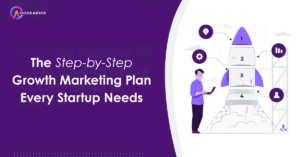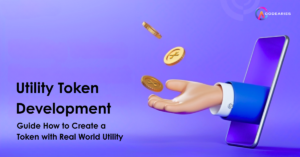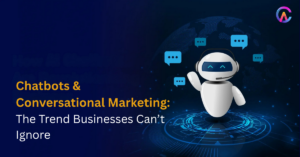Growth marketing has become essential for startup success in 2025. It combines creativity, data, experiments, and technology to create a system for scalable and sustainable growth. Unlike traditional marketing, which focuses on acquiring customers, growth marketing improves the whole customer journey, including acquisition, activation, retention, referral, and revenue, through ongoing iterations and quick learning cycles. For startups seeking traction in competitive markets, having a solid growth marketing plan is necessary.
This guide will take you through a tested step by step growth marketing plan for startups. It explains each phase in detail, points out common mistakes, and offers practical strategies. At the end, learn how Codearies collaborates with startups to speed up their journey and find answers to frequently asked questions about growth marketing for new ventures.

Step 1: Clarify Your Value Proposition and Brand Positioning
Start by explaining why your product is important. Success depends on:
- Clear value proposition: What unique problem do you solve, and for whom?
- Brand positioning: How do you stand out from competitors? What voice, style, and identity resonate with your ideal customer?
- Messaging framework: Keep your website, pitches, ads, and content consistent to quickly convey your value.
Tip: Use customer interviews and competitor research to refine your unique story before launching any campaigns.
Step 2: Define and Segment Your Target Audience
You can’t grow without knowing whom you want to serve.
- Build detailed customer personas: Include demographics, psychographics, pain points, digital habits, and buying triggers.
- Segment your audience: Personalize your messaging for each segment to ensure its relevance and increase conversion rates.
Ask yourself: Who benefits most from our solution? Which early adopters will help drive referrals or testimonials?
Step 3: Validate Market Need and Product Solution Fit
Even the best marketing won’t help a product that nobody wants.
- Conduct lean experiments: Use landing pages, pre signup campaigns, and prototype demos to confirm demand.
- Gather early feedback: Utilize surveys, interviews, and analytics to iterate until you see signs of genuine interest and intent
- Set clear metrics: such as landing page signup rate, demo attendance, or free to paid conversion rates.
Step 4: Build a Conversion Optimized Digital Experience
Your digital presence is your storefront, make it work for you.
- Launch a fast, user friendly website: Clearly articulate your value, use strong calls to action, and ensure your site is mobile-friendly.
- Implement SEO best practices: Make sure your site ranks for target keywords and includes relevant content for your audience’s needs.
- Set up web analytics: Use tools like Google Analytics, Hotjar, or Mixpanel to monitor user flows and conversion rates.
Step 5: Craft a Multi Channel Acquisition Strategy
Growth marketing thrives on experimentation, don’t rely on a single channel!
- Content Marketing: Publish educational blogs, guides, infographics, and videos to establish authority and attract organic traffic.
- Social Media: Focus on platforms where your audience spends time. Be genuine and use both organic and paid methods.
- Email Marketing: Start building your list from day one. Provide subscribers with valuable content and early access offers.
- Paid Ads: Use Google Ads, LinkedIn, or Meta to target segments for measurable ROI. Start with small budgets, optimize using A/B tests, and scale what works.
- Partnerships & Influencer Campaigns: Collaborate with industry experts, creators, and affiliates for credibility and reach.
Tip: Prioritize channels based on customer acquisition cost, scalability, and where you see early success.
Step 6: Activation: Turn Visitors into Engaged Users
Acquisition means little without activation. Focus on:
- Onboarding flows: Make it easy for new users to set up and see value.
- Guided tours, product videos, and support: Help users reach their “aha moment” faster.
- Email/SMS drip campaigns: Welcome new users, celebrate milestones, and encourage deeper interaction.
Step 7: Retention & Lifecycle Marketing
Retention is more cost effective than acquisition. Drive loyalty by:
- Personalized engagement: Use triggers, segmentation, and behavioral data for relevant messaging.
- Product updates & feature announcements: Keep users excited and in the loop.
- Customer feedback loops: Gather insights through surveys, reviews, and direct outreach, then act on the results.
Step 8: Build Referral Engines & Growth Loops
Turn your delighted users into advocates.
- Referral programs: Reward users for sharing your product.
- Viral product features: Make sharing, inviting, or content creation an integral part of your app or service.
- Community building: Encourage user generated content, testimonials, and case studies.

Step 9: Track, Analyze, and Iterate
Growth is data driven and relentless.
- Define key metrics: Track customer acquisition cost, customer lifetime value, activation rates, retention, churn rate, return on ad spend, and user engagement.
- A/B test relentlessly: Change headlines, landing pages, emails, ads, and onboarding steps.
- Rapid experimentation: Launch small tests, expand what works, and move away from what doesn’t.
- Growth loops: Create loops where each new user brings in another, enhancing every success.
Step 10: Scale: Automate, Optimize, and Expand
Once early signals are validated, and systems show repeatability:
- Automate repetitive marketing and sales tasks using CRM, email, and chatbot tools.
- Expand into new channels or markets with tailored strategies.
- Invest in paid growth and partnerships based on your tracking and ROI insights.
- Keep innovating: Growth marketing is never ‘set and forget’, it flourishes with ongoing flexibility.
Common Mistakes to Avoid
- Chasing growth tactics before clarifying product market fit
- Overlooking customer success and retention while pursuing acquisition.
- Ignoring analytics or failing to define clear KPIs
- Relying on a single growth channel
- Skipping structured feedback and iteration cycles
Growth Marketing in 2025: Trends to Watch
- AI driven personalization and automation for smarter targeting and prediction
- Growth loops, where product features naturally drive referrals, replace one off campaigns.
- Collaborations with communities and micro influencers instead of mass market influencers.
- Programmatic SEO and hyper relevant content for organic discovery
How Codearies Supercharges Startup Growth Marketing
At Codearies, we assist startups in creating, executing, and scaling growth marketing plans that avoid costly mistakes and unlock long term results.
Our Services:
- Growth Strategy Consulting: In depth audits, market and competitor research, and custom growth roadmaps.
- Full Funnel Implementation: From acquisition and onboarding to retention, referral, and revenue scaling.
- Data Analytics & Experimentation: Custom dashboards, A/B testing, attribution modeling, and automation.
- Omni Channel Execution: Paid ads, SEO, email, influencer, and partnership campaigns.
- Product Led Growth: Advice on integrating growth loops, viral features, and referral mechanics into your product.
- Continuous Improvement: Regular strategy updates, user feedback cycles, and flexible campaign optimization.
With Codearies by your side, your startup can concentrate on what truly matters, sustainable and scalable growth.
Frequently Asked Questions (FAQ)
Q1: How quickly should startups expect results from growth marketing?
Most startups notice early indicators, like increased sign ups or engagement, within 4 to 8 weeks if their initial experiments are well structured and data driven, with increasing ROI as the plan develops.
Q2: Can Codearies help startups that haven’t found product-market fit yet?
Absolutely, We help confirm demand, run lean tests, and shape iterations so you avoid spending on channels that don’t resonate with the target market.
Q3: What growth metrics matter most for startups?
Key metrics include customer acquisition cost, customer lifetime value, activation rate, churn and retention rates, referral rate, and return on ad spend.
Q4: How does Codearies tailor strategies for B2B vs. B2C startups?
We develop buyer journeys, content, and channels suited to your specific market and sales cycle, whether your target is consumers or enterprise clients.
Q5: How does growth marketing differ from traditional marketing?
Growth marketing is driven by data and experimentation, covers the complete customer journey (not just the beginning), and promotes constant testing and optimization rather than fixed, broad campaigns.
For business inquiries or further information, please contact us at







